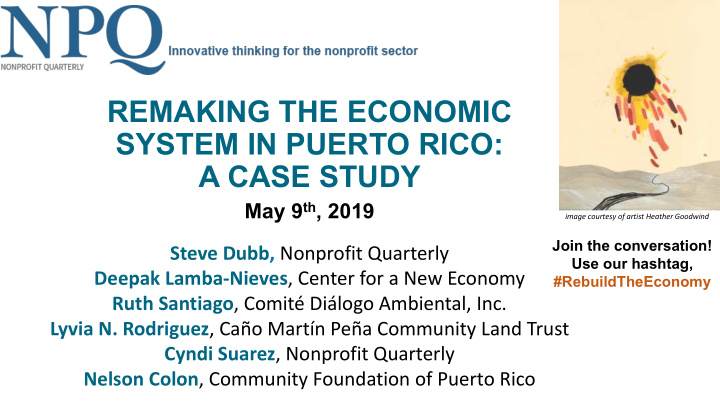



REMAKING THE ECONOMIC SYSTEM IN PUERTO RICO: A CASE STUDY May 9 th , 2019 image courtesy of artist Heather Goodwind Join the conversation! Steve Dubb, Nonprofit Quarterly Use our hashtag, Deepak Lamba-Nieves , Center for a New Economy #RebuildTheEconomy Ruth Santiago , Comité Diálogo Ambiental, Inc. Lyvia N. Rodriguez , Caño Martín Peña Community Land Trust Cyndi Suarez , Nonprofit Quarterly Nelson Colon , Community Foundation of Puerto Rico
Series Overview Remaking the Community Land Community-Owned Economy Ownership Business 11-8-2018 12-13-2018 1-10-2019 Building Policy Community Leveraging Agendas Capital & Finance “Eds & Meds” 4-11-2019 2-14-2019 3-14-2019 And beyond! How to Succeed at Changing the System 5-9-2019
Series Learning Objectives • Clarify core principles • Develop a toolkit • Understand ecosystems • Identify ways to decolonize wealth and foster racial equity • Highlight points of leverage • Foster shifts in practice and thinking • Balance short-term goals with long-term vision
Understanding Systems and System Change Key Principles 1. No system is ever total. 2. Systems overlap. 3. Systems evolve. 4. System change is rarely total. 5. New systems emerge out of the shell of the old.
Possible Systemic Changes in Puerto Rico 1. Rise of an equity approach (Nelson Colón) 2. A new approach to the role of the state/new fiscal model (Deepak Lamba Nieves) 3. Redefining what counts as “capital” (Nelson Colón) 4. Sectoral innovation a. Housing/land tenure (Lyvia Rodriguez) b. Energy (Ruth Santiago)
Implications for the US Mainland—and Beyond 1. Justice Funders: equity approach in the Bay Area. 2. Elizabeth Castillo: multiple capitals framework. 3. Rise of community land trusts, worker co- ops nationwide. 4. Calls for a Green New Deal—could Puerto Rico be modeling the future?
Source: CNE Analysis of Puerto Rico Planning Board Data
Opportunities Amidst Disasters Energy Housing Fiscal Rules
Energy • Puerto Rico is transitioning from a centralized system to one based on distributed generation using renewable sources of energy. • Puerto Rico's new electrical system should maximize integration of renewable generation capacity systems and storage technologies. • Solving the island’s energy crisis will go a long way towards reducing utility costs, increasing economic efficiency, and reducing environmental degradation, amongst other benefits.
Housing • The government of Puerto Rico has delineated a series of strategies for meeting the post-disaster housing needs on the island, but a comprehensive framework is needed. • Given this situation, the Center for a New Economy (CNE) established the Blueprint Initiative : a research, knowledge exchange, and advocacy platform. • Three key areas: land tenure, housing affordability, safe housing.
Fiscal Rules • Fiscal rules are mechanisms that allow for the establishment of monitorable fiscal targets and strategies. • In 2016, CNE recommended the adoption of a Fiscal Responsibility Law with two components: (1) a simple, intuitive, and objective fiscal rule; and (2) procedural guidelines that support a large-scale overhaul of systems, institutions, and practices. • Designing and implementing clear fiscal rules will also encourage institutional reforms to build state capacity.
It seems clear that how Puerto Rico recovers from the disasters will determine how the island grows.
Lessons (Hopefully) Learned From Hurricane Maria • PR is part of the Caribbean “Continent of Islands” in the hurricane route. • Vertical poles and transmission towers/lines crossing the central mountain range and tropical forests don’t hold up to hurricane-force winds. • Solar holds up better. • Communities NEED to participate in electric power generation and other energy issues.
Foundations for the Transformation • 65% of residential roofs could generate all of Puerto Rico’s energy http://www.uprm.edu/aret/docs/Ch_1_Summary.pdf, p. 1-13 to 1-14. • The siting of solar systems on previously contaminated land. See http://www.osti.gov/bridge. • We Want Sun https://www.queremossolpr.com
Viability-Power Electronics, Renewables • A Customer-focused Framework for Electric System Resilience , Silverstein, A. et al. • Voltage support • Frequency support: stabilization following a disturbance, ramping and balancing, peak energy in summer • A Case Study of Residential Electric Service Resiliency thru Renewable Energy Following Hurricane María, Irizarry, A. Montano, K, Alzate, S., Andrade, F.
Economic Viability of Rooftop Solar • The draft Integrated Resource Plan (IRP) prepared by Siemens for the Puerto Rico Electric Power Authority (PREPA) (pages 8-30 and 8-46 of the IRP): Cost of customer-owned generation is significantly lower than the total rate. • In spite of this, customer-owned solar is severely limited to about 10% of the generation mix in 2038. • Credit Union financing for solar kits
Fuel Infrastructure Options Source: Siemens
Th Thank y you f for jo join inin ing us! s! Nonprofit Quarterly relies on your generous support. If you enjoyed this webinar, please consider donating today! https://nonprofitquarterly.networkforgood.com/ Tell us what you thought! Use our special hashtag, #Re RebuildTheEconomy image courtesy of artist Heather Goodwind
Recommend
More recommend